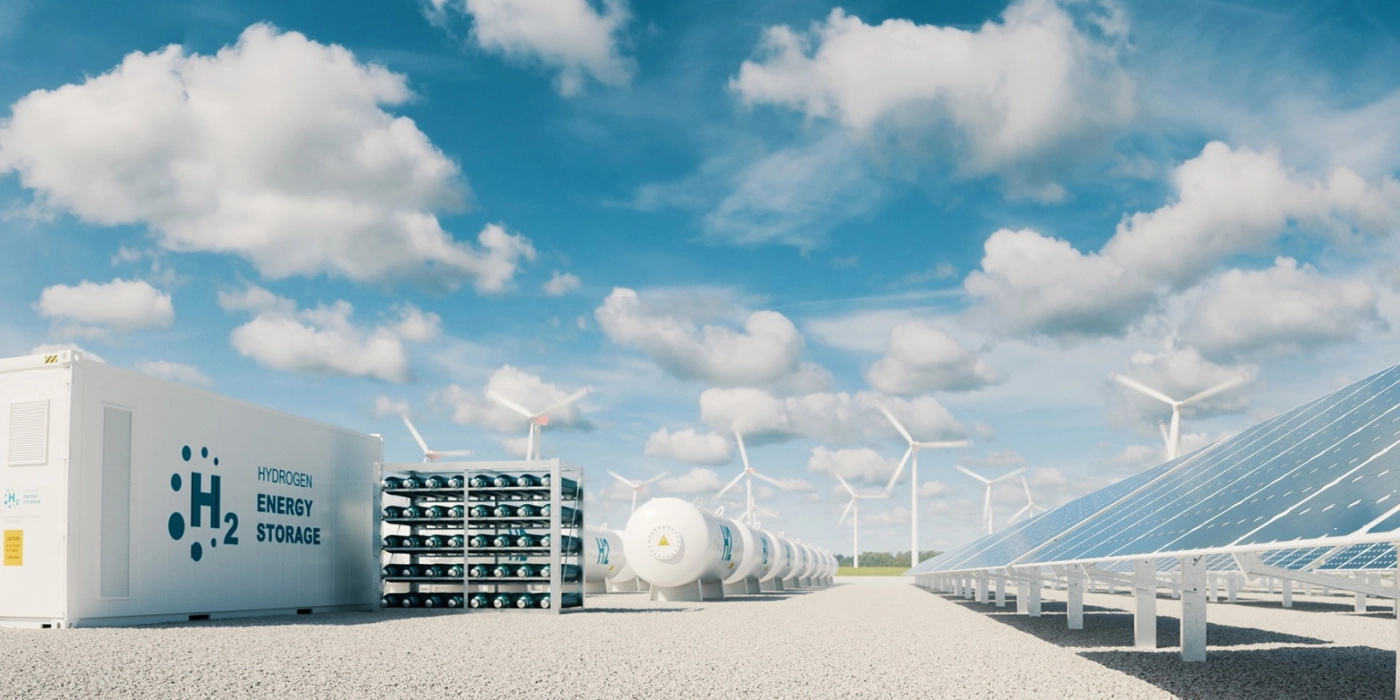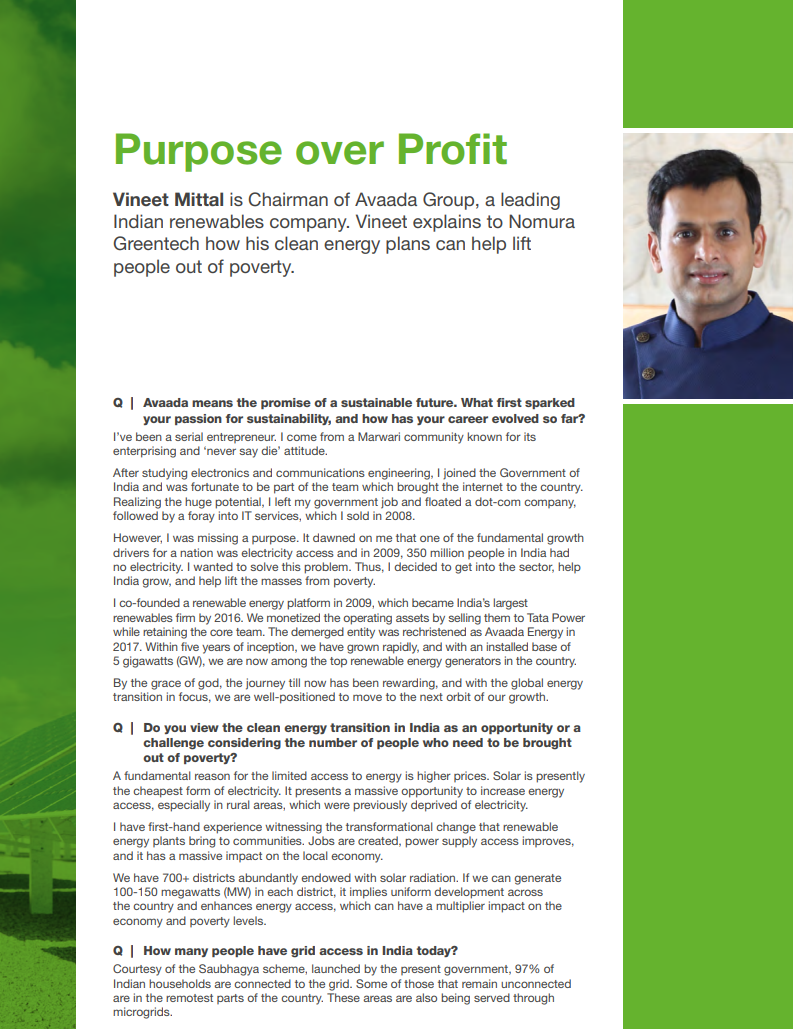-
After the US and China, India is the third largest emitter of greenhouse gases, and home to 5 of the most polluted cities in the world
-
The biggest challenges in India are grid connectivity and land access, and players who successfully navigate these twin challenges will be the winners
-
India’s 2070 net zero goal is ambitious but the real action will start in 2023 with a huge expansion in the manufacturing of solar panels, batteries, wind turbines and electrolyzers
Avaada means the promise of a sustainable future. What first sparked your passion for sustainability, and how has your career evolved so far?
I’ve been a serial entrepreneur. I come from a Marwari community known for its enterprising and ‘never say die’ attitude. After studying electronics and communications engineering, I joined the Government of India and was fortunate to be part of the team which brought the internet to the country. Realizing the huge potential, I left my government job and floated a dot-com company, followed by a foray into IT services, which I sold in 2008.
However, I was missing a purpose. It dawned on me that one of the fundamental growth drivers for a nation was electricity access and in 2009, 350 million people in India had no electricity. I wanted to solve this problem. Thus, I decided to get into the sector, help India grow, and help lift the masses from poverty.
I co-founded a renewable energy platform in 2009, which became India’s largest renewables firm by 2016. We monetized the operating assets by selling them to Tata Power while retaining the core team. The demerged entity was rechristened as Avaada Energy in 2017. Within five years of inception, we have grown rapidly, and with an installed base of 5 gigawatts (GW), we are now among the top renewable energy generators in the country.
Do you view the clean energy transition in India as an opportunity or a challenge considering the number of people who need to be brought out of poverty?
A fundamental reason for the limited access to energy is higher prices.
Solar is presently the cheapest form of electricity. It presents a massive opportunity to increase energy access, especially in rural areas, which were previously deprived of electricity.
I have first-hand experience witnessing the transformational change that renewable energy plants bring to communities. Jobs are created, power supply access improves, and it has a massive impact on the local economy.
We have 700+ districts abundantly endowed with solar radiation. If we can generate 100-150 megawatts (MW) in each district, it implies uniform development across the country and enhances energy access, which can have a multiplier impact on the economy and poverty levels.
How many people have grid access in India today?
Courtesy of the Saubhagya scheme, launched by the present government, 97% of Indian households are connected to the grid. Some of those that remain unconnected are in the remotest parts of the country. These areas are also being served through microgrids.
The only challenges I foresee are hours of supply.
Electricity distribution companies are in financial distress, and it’s less profitable to supply consumers in remote areas. However, things have improved considerably in the last few years, and I am sure energy access won’t be a major issue in times to come.
Is India’s 2070 net zero goal ambitious enough considering what’s at stake with climate disasters intensifying?
I see that the 2070 target may not look ambitious, but we are putting enormous efforts into adopting renewable energy across the spectrum, including for farmers, industry and households.
What our Prime Minister is trying to do through his five nectar elements (Panchamrit) of India’s climate action or five commitments (including 50% renewable energy by 2030) to decarbonize India, is very encouraging.
Isn’t decarbonization even more important for India as it bears the brunt of severe heat waves and flooding?
Even if a single life is lost due to a flood or natural disaster, it’s not acceptable to any country’s leadership, let alone India. India is becoming more conscious of its role in stabilizing global carbon emissions. We are still one of the lowest emitters of greenhouse gases per capita but our large population increases our overall emissions.
We will continue the good work, but we must also engage and negotiate harder with world leaders, especially developed countries, to do more.
Which areas of green energy is Avaada focused on, and what are your targets for the coming decade?
If I have to describe to you in a single sentence, we will be a sand-to-molecule company. We will convert sand into silica, silica into wafer, wafer into cell, cell into module, module into electricity, and electricity into green ammonia, green methanol and sustainable aviation fuel (SAF).
What does that mean? Currently, we have almost 4 GW of operating assets. We are looking to add around 3 GW + every year for the next decade to become a 30 GW company by 2030. So our end goal is to sell green molecules, not green energy.
For our renewable energy portfolio, we are targeting 1 GW of electrolyzer manufacturing and almost 10 GW of silica to module manufacturing. We see tremendous opportunity in this area. Even if we only capture a 3-4% market share, that would be large enough to make it a success.
We already have a 5% market share for green energy in India. We have built expertise around energy performance contracts, execution, and community relationships, which are central to resolving the allocation of transmission lines for large land acquisitions.
Is India too dependent on imports for components like solar panels to meet its sustainability targets?
Yes, the Indian Government has come out with a very ambitious plan called ‘Self-Reliant India’, in which it allocated $26 billion under the production linked incentive (PLI) scheme. The goal is to encourage domestic manufacturing and make India self-sufficient for supplies of major inputs across industries.
Under the PLI scheme, Solar PV manufacturing has been allocated almost $3 billion. The first tranche of bidding has already been concluded, and the second round is expected soon.
This will help bolster energy security. India also has the chance to build a very strong supply chain in semiconductors and renewable energy components.
You recently signed an agreement to set up a green ammonia facility in Rajasthan. Is there more to come in this space?
We are heavily focused on green hydrogen and its derivatives like green ammonia, green methanol and SAF. India is already blessed with an abundance of sun and wind, the key inputs for the production of green ammonia which positions it perfectly to become a global manufacturing hub for green hydrogen.
We plan to sign agreements with more Indian States for grid and land access.
The Government of India is also working on imposing green hydrogen / ammonia purchase obligations on certain sectors, and once that kicks in, it will also create massive domestic demand.
Are the prospects good for independent power producers in India like yourself?
It’s a huge opportunity. The renewable installed capacity targets are 500 GW by 2030, and we are still at around 120 GW. It implies annual capacity addition of ~40 GW. This will include a huge public procurement marketplace and open access segment for commercial & Industrial consumers.
Disclaimer
This content has been prepared by Nomura solely for information purposes, and is not an offer to buy or sell or provide (as the case may be) or a solicitation of an offer to buy or sell or enter into any agreement with respect to any security, product, service (including but not limited to investment advisory services) or investment. The opinions expressed in the content do not constitute investment advice and independent advice should be sought where appropriate.The content contains general information only and does not take into account the individual objectives, financial situation or needs of a person. All information, opinions and estimates expressed in the content are current as of the date of publication, are subject to change without notice, and may become outdated over time. To the extent that any materials or investment services on or referred to in the content are construed to be regulated activities under the local laws of any jurisdiction and are made available to persons resident in such jurisdiction, they shall only be made available through appropriately licenced Nomura entities in that jurisdiction or otherwise through Nomura entities that are exempt from applicable licensing and regulatory requirements in that jurisdiction. For more information please go to https://www.nomuraholdings.com/policy/terms.html.





